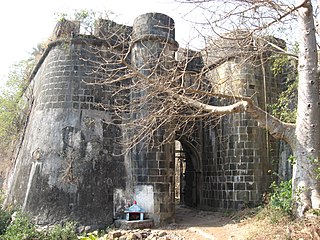
Bombay State was a large Indian state created at the time of India's Independence, with other regions being added to it in the succeeding years. Bombay Presidency was merged with the princely states of the Baroda, Western India and Gujarat and Deccan States (which included parts of the present-day Indian states of Maharashtra and Karnataka.

Mumbai City District is a district of Maharashtra in Konkan Division. As a city district, it has no headquarters or subdivisions. It, along with the Mumbai Suburban District, makes up the metropolis of Mumbai. The city area is called the "island city" or South Mumbai or Old Mumbai. It extends from Colaba in the south to Mahim and Sion in the north. The city has an area of 157 km² and a population of 3,085,411.
Mallikarjuna was an Indian ruler from the Shilahara dynasty. He ruled northern Konkan from 1155–1170 CE.

The Shilahara Dynasty was a royal clan that established itself in northern and southern Konkan, present-day Mumbai and southern Maharashtra during the Rashtrakuta period.
Goggiraja was Shilahara ruler of north Konkan branch from 930 CE – 945 CE.
Aparajita was Shilahara ruler of north Konkan branch from 975 CE – 1010 CE.
Arikesarin was Shilahara ruler of north Konkan branch from 1015 CE – 1022 CE.
Chhittaraja was Shilahara ruler of north Konkan branch from 1022 CE – 1035 CE.
Gandaraditya : Bhoja I was succeeded by Gandaraditya. who claimed to be the undisputed king of Konkan. During the later period of his regime, his son Vijayaditya defeated Jayakesin II of Goa who had ousted the Shilahara ruler of Thane. Gandarditya executed various public works. At Irukudi in Miraj district he built a lake called Gandusamudra on the bank of which he built temples in honour of Buddha, Jina and Sankara.
Human habitation of Mumbai existed since the Stone Age, the Kolis were the earliest known settlers of the islands. The Maurya Empire gained control of the islands during the 3rd century BCE and transformed it into a centre of Buddhist culture and religion. Later, between the 2nd century BCE and 9th century CE, the islands came under the control of successive indigenous dynasties: Satavahanas, Abhiras, Vakatakas, Kalachuris, Konkan Mauryas, Chalukyas and Rashtrakutas, before being ruled by the Silharas from 810 to 1260.
The Ancient history of Mumbai recounts the history of Mumbai from 300 BCE to 1348 CE.
The history of Mumbai under Islamic rule began in 1348 and continued until 1534.

Bombay, now called Mumbai, Bombaim in Portuguese, is the financial and commercial capital of India and one of the most populous cities in the world. At the time of arrival of the Portuguese, current Bombay was an archipelago of seven islands. Between the third century BCE and 1348, the islands came under the control of successive Hindu dynasties. The Muslim rulers of Gujarat, who had been ruling current Thane and Vasai for a few decades, annexed the islands in 1348, that were later governed by the Gujarat Sultanate from 1391 to 1534. Growing apprehensive of the power of the Mughal emperor Humayun, Sultan Bahadur Shah of the Gujarat Sultanate was obliged to sign the Treaty of Bassein with the Portuguese Empire on 23 December 1534. According to the treaty, the seven islands of Bombay, the nearby strategic town of Bassein and its dependencies were offered to the Portuguese. The territories were later surrendered on 25 October 1535.
Bombay, now called Mumbai, Bombaim in Portuguese, is the financial and commercial capital of India and one of the most populous cities in the world.
Sir Abraham Shipman was an Englishman appointed as governor of Bombay during the period of the Honourable East India Company. He assumed the office in March 1662 and died in office in October 1664, but did not gain possession of Bombay.
Stephen Law was the Governor of Bombay from 7 April 1739 to 15 November 1742.

The military history of Bassein encompasses the period from 1526, when the Portuguese established their first factory at Bassein, until 1818, when Bassein lost its strategic importance following the defeat of the Marathas by the British.

The Government of Maharashtra is the government for the state of Maharashtra in Western India. It is an elected government with 288 MLAs elected to the legislative assembly for a five-year term. Maharashtra has a bicameral legislature i.e. it consists of two houses: Vidhan Sabha and Vidhan Parishad. As is the case in a parliamentary system, the government is formed by the party, alliance or group of assembly members who command the majority, in the lower house. The leader of the majority in lower house becomes the Chief Minister and selects the cabinet members, from either lower (or) upper house. If one becomes CM or minister without being an MLA or MLC, he/she must become either of one within next 6 months. From the formation of the state in 1960, the Congress party or Congress-led alliance have ruled the state for the major part. Non-Congress government was first formed in 1978, then in 1995 with Shivsena-BJP alliance, and most recently in 2014 with a BJP-led alliance.






